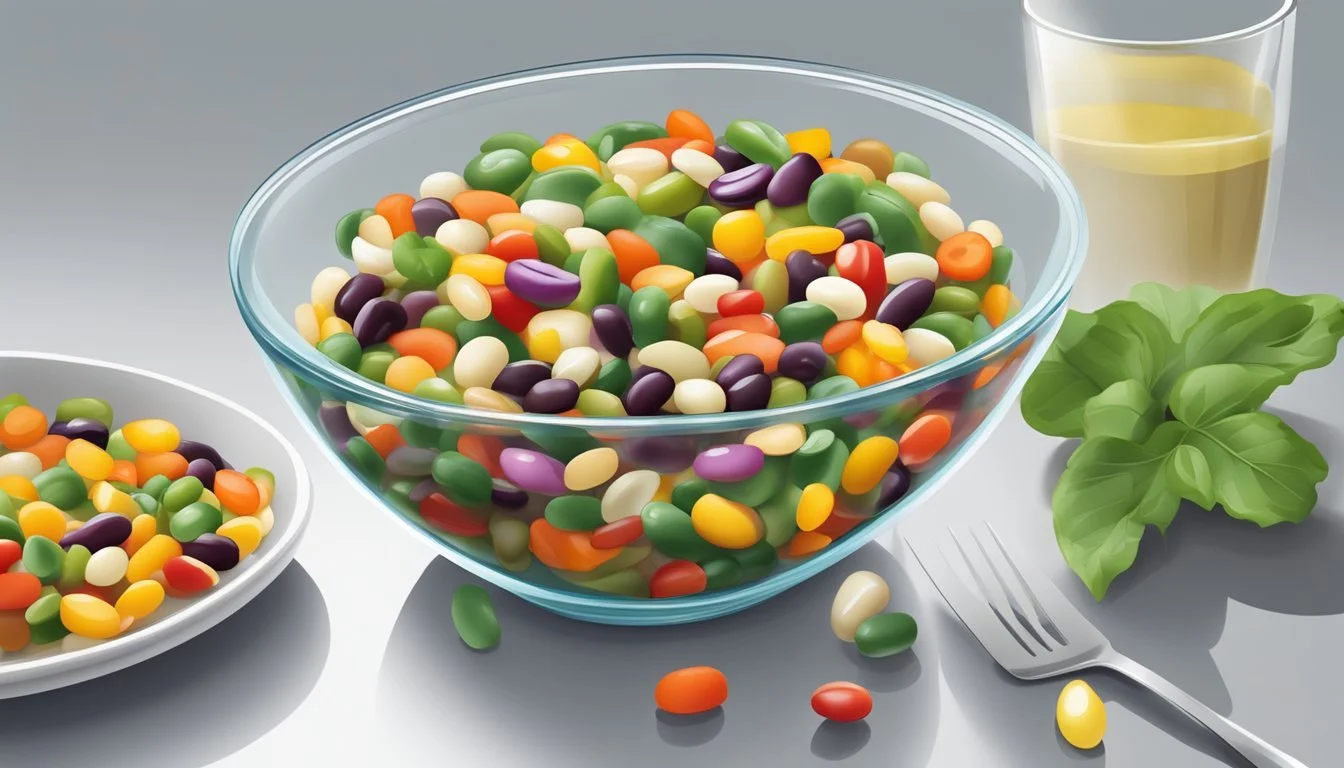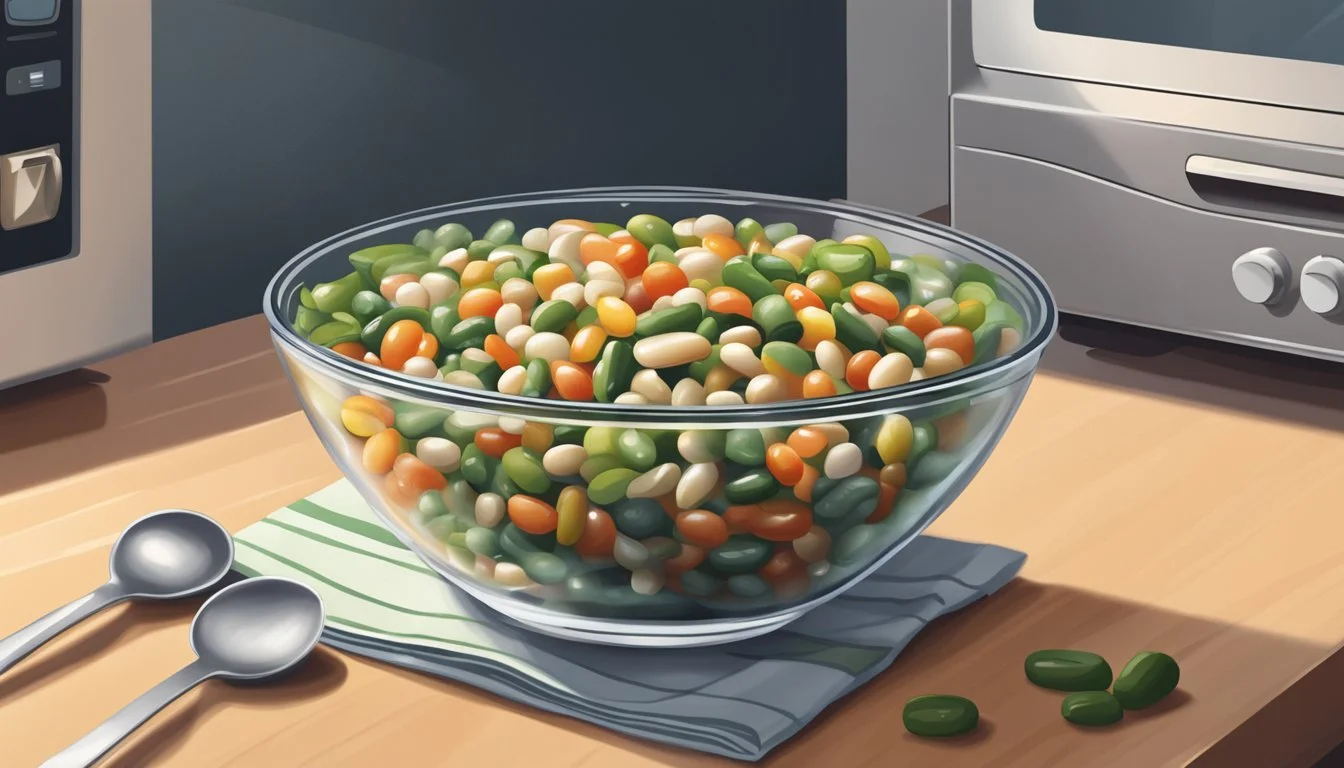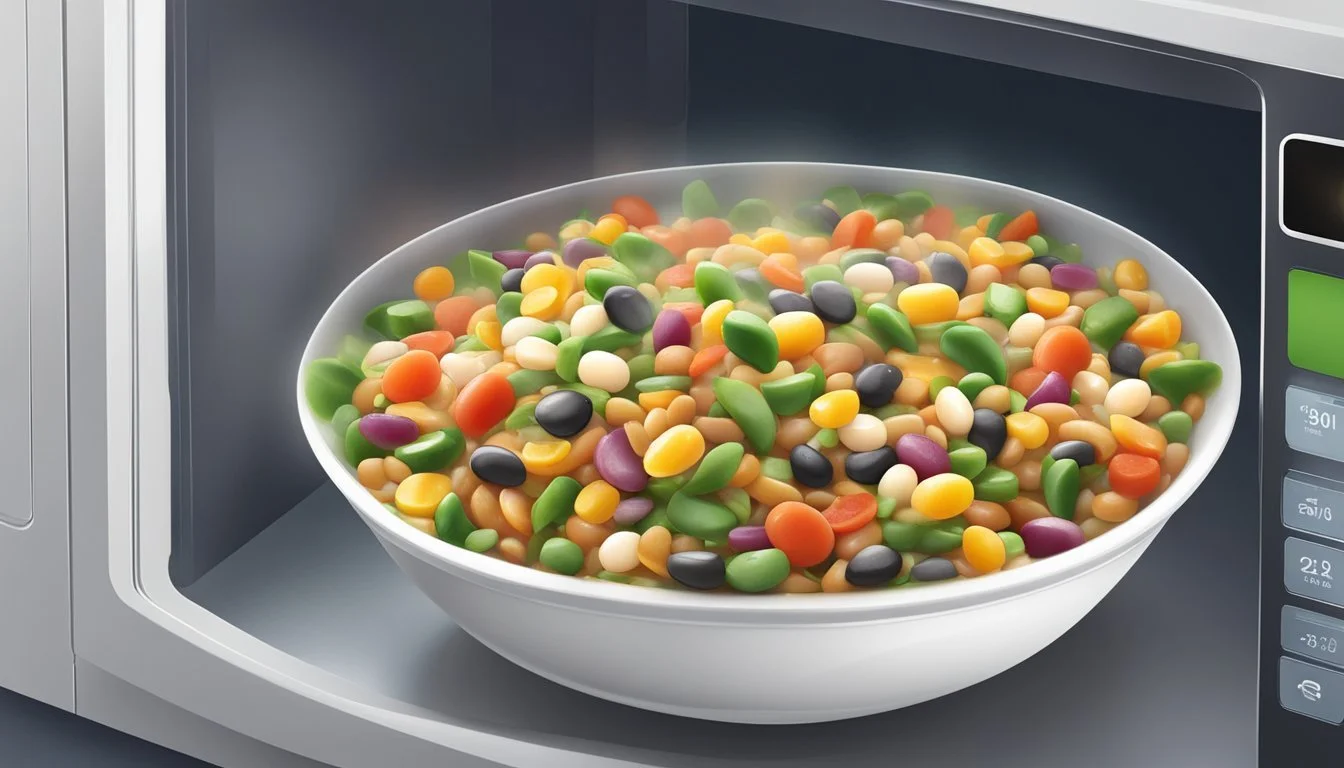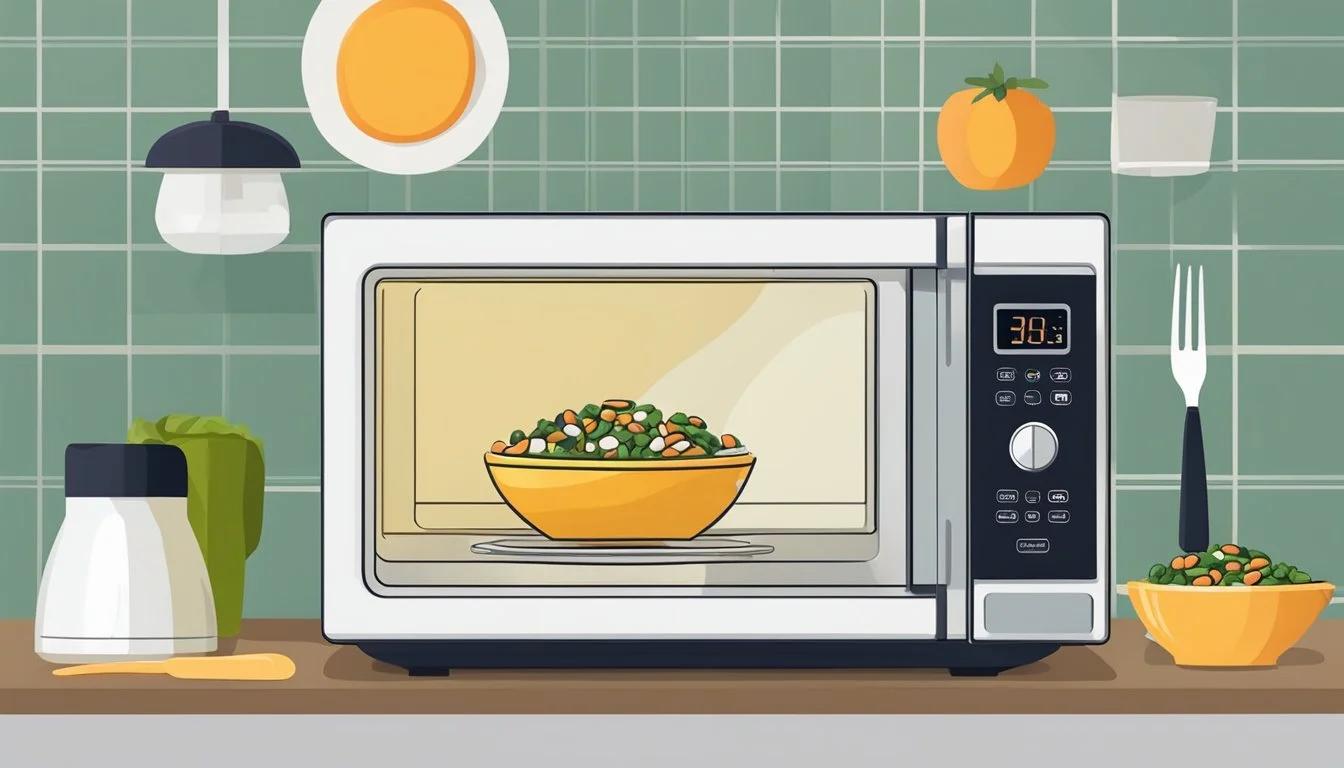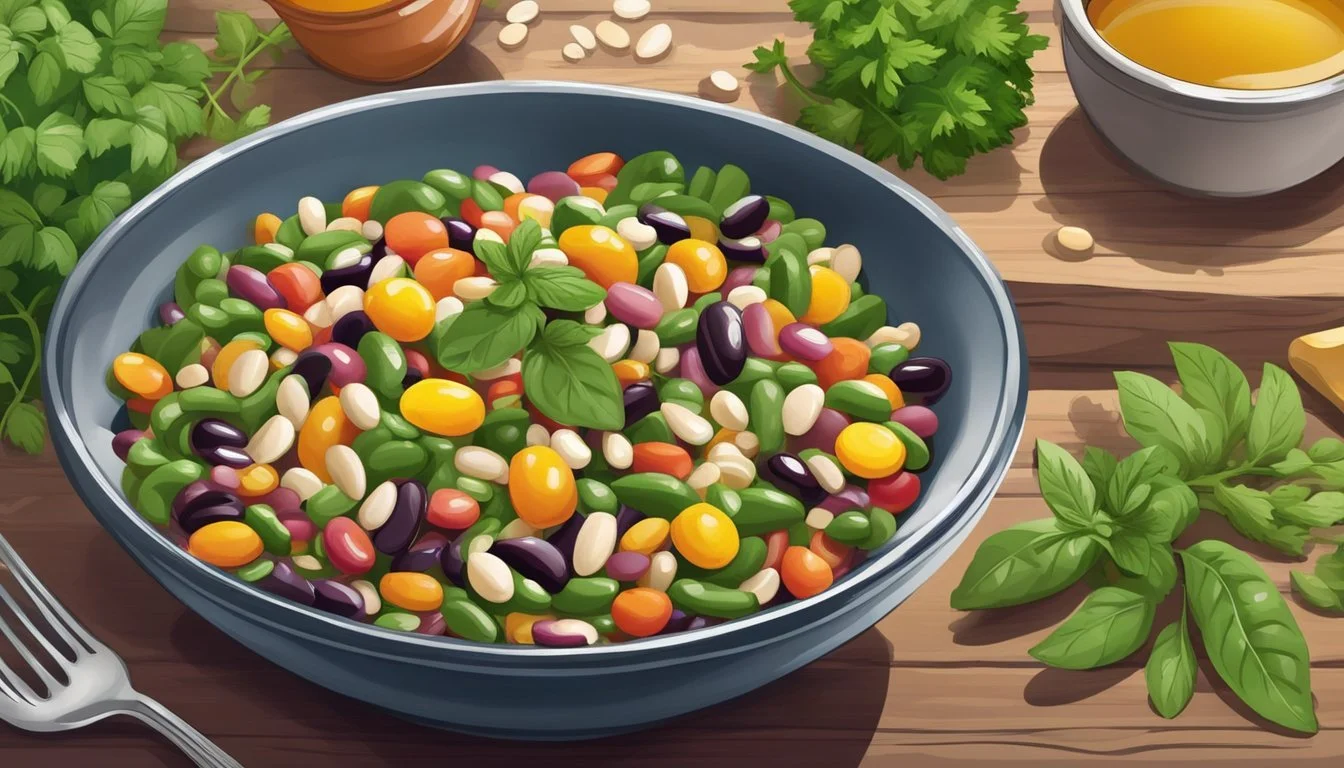How to Reheat Gluten-Free Three Bean Salad
Quick and Easy Tips
Reheating a gluten-free three bean salad is a simple yet essential skill for maintaining its delicious and nutritious qualities. To reheat a gluten-free three bean salad, it is crucial to avoid microwaves and instead utilize gentle stovetop heating. This method ensures the integrity of the beans and vegetables, keeping them tender and flavorful.
As a popular and healthy side dish, especially during summer potlucks and family gatherings, three bean salad blends the vibrant textures of chickpeas, kidney beans, and green beans with a refreshing vinegar-based dressing. This combination not only pleases the palate but also delivers a nutritious punch, rich in fiber and plant-based protein.
When prepared correctly, a reheated three bean salad continues to offer the same delightful experience as when freshly made. Whether served to friends at a picnic or to family at a dinner table, maintaining the salad's quality through proper reheating techniques guarantees that everyone enjoys this healthy and satisfying dish.
Understanding Gluten-Free Three Bean Salad
Gluten-free three bean salad offers a nutritious and tasty option for various diets. This section will explore the nutritional benefits and common ingredients in this simple yet versatile salad.
Nutritional Benefits
A gluten-free three bean salad is packed with nutrients. The combination of beans provides a good source of protein, essential for muscle repair and growth. For example, kidney beans, black beans, and chickpeas each deliver 7-8 grams of protein per 1/2 cup serving.
This salad is also high in fiber, which aids digestion and helps maintain a healthy weight. Fiber content ranges from 6-8 grams per serving, depending on the mix of beans.
Carbohydrates are another component, offering a steady energy source. Beans provide complex carbohydrates, which release energy gradually. This dish is typically low in fat, especially if an oil-free dressing is used.
Vitamins and minerals such as iron, calcium, and potassium are also plentiful. For instance, a serving can contribute significantly to daily iron intake, crucial for preventing anemia.
Caloric content often remains moderate, between 100-150 calories per serving, making it a satisfying yet light option.
Common Ingredients
Common ingredients in gluten-free three bean salad include chickpeas, kidney beans, and green beans. These beans are usually drained and rinsed before being mixed.
Additional components often involve chopped green or red bell peppers, which provide a crisp texture and vitamin C. Celery and green onions are other common additives, providing extra crunch and flavor.
The dressing typically combines olive oil, apple cider vinegar, sugar, salt, and pepper. This mixture balances the salad's flavors, offering a tangy and slightly sweet taste.
Some variations might include black beans and cannellini beans to diversify the flavor and texture. Each bean type brings its own unique nutritional profile, contributing to the salad's overall health benefits.
Using fresh herbs like cilantro adds an aromatic touch and additional vitamins. Each ingredient in the gluten-free three bean salad plays a part in creating a nutritious and delicious dish.
Preparation Tips Before Reheating
Proper preparation sets the foundation for a flavorful and enjoyable gluten-free three bean salad. Focus on cooking the beans from scratch, selecting fresh ingredients, and creating a flavorful dressing.
Cooking Beans from Scratch
Cooking beans from scratch enhances their flavor and texture.
First, soak the beans overnight in plenty of water. Drain and rinse them before cooking. Using fresh water, bring the beans to a boil, then reduce the heat and simmer until they are tender. Add a bay leaf and some sea salt to the cooking water for added flavor.
Avoid overcooking the beans as they can become mushy. Using fresh beans rather than canned ensures they absorb the homemade flavors more effectively, making the salad more vibrant and fresh.
Choosing Fresh Ingredients
Selecting high-quality, fresh ingredients is crucial for a delicious salad.
Opt for fresh vegetables like bell peppers, red onions, and cherry tomatoes. When available, pick organic ingredients to enhance the taste and nutrients. Use fresh herbs such as parsley, cilantro, and basil to add aromatic depth to the salad.
For a balanced flavor, season the salad with sea salt and freshly ground black pepper. Avoid pre-chopped vegetables or herbs since they can lose flavor quickly, reducing the overall quality of your dish.
Making the Dressing
The dressing profoundly influences the salad's final taste.
Combine extra-virgin olive oil, apple cider vinegar, Dijon mustard, lemon juice, sea salt, and black pepper for a zesty and balanced dressing. Sweeten it slightly with pure maple syrup or agave. Whisk these ingredients together until they are well mixed.
Consider adding dried herbs like oregano or thyme for an extra layer of flavor. Adjust the seasoning to taste, ensuring a good balance between acidity, sweetness, and seasoning. The carefully crafted dressing can elevate the flavors, making the salad refreshing and delicious.
Proper Storage for Freshness
Maintaining the freshness of your gluten-free three bean salad hinges on proper refrigeration and the use of the right storage containers. Follow these guidelines to ensure your salad stays delicious and safe to eat.
Refrigeration Guidelines
Store your three bean salad in the refrigerator immediately after preparation. Keeping the salad cold slows bacterial growth and preserves its taste and texture.
Ideal Temperature: Ensure the refrigerator is set to 40°F (4°C) or lower. This temperature range is optimal for keeping the salad fresh.
Shelf Life: Consume the salad within 3-4 days. While refrigeration helps, the dressing and vegetables can still degrade over time, impacting both flavor and safety.
Placement: Place the salad on a middle or top shelf in the refrigerator. This area maintains a consistent temperature and avoids potential contamination from raw meats or other perishables.
Using the Right Containers
Selecting the appropriate container for storing your three bean salad is crucial. Use only airtight containers to keep the salad fresh longer.
Types of Containers:
Airtight Plastic Containers: Ensure the lids snap on tightly.
Glass Containers: Many prefer these for their non-reactivity and ease of cleaning.
Mason Jars: Excellent for portioning and preserving freshness. Their tight seals are ideal for salads.
Seal Quality: Check that the containers you choose have reliable seals. This prevents external air and contaminants from affecting the salad.
Proper storage in airtight containers not only retains freshness but also prevents the salad from absorbing other odors in the refrigerator.
Reheating Methods for Optimal Texture
Ensuring that your gluten-free three bean salad retains its texture and flavor means choosing the right reheating method. Here, we explore three effective techniques: microwave, oven, and stovetop.
Microwave Technique
The microwave is a quick and convenient way to reheat gluten-free three bean salad. To prevent the beans from becoming soggy or overly soft, place the salad in a microwave-safe dish and cover it with a microwave-safe lid or paper towel.
Instructions:
Distribute Evenly: Spread the salad evenly in the dish for uniform heating.
Add Moisture: Add a small amount of water or broth to the dish to maintain moisture.
Heat on Medium: Microwave on medium power for 2-3 minutes, checking and stirring halfway through.
This method ensures the beans are heated through without losing too much texture.
Oven Reheating
Reheating in the oven is ideal for those who want to preserve the crispness of certain ingredients within the salad. Preheat the oven to 350°F (175°C).
Instructions:
Transfer and Cover: Transfer the salad to an oven-safe dish and cover loosely with aluminum foil.
Reheat Evenly: Bake for 10-15 minutes, stirring occasionally to ensure even heating.
Avoid Dryness: Optionally, add a splash of olive oil or broth to prevent dryness.
This method helps retain texture and flavor, making the salad taste almost as fresh as when it was first prepared.
Stovetop Method
Using a stovetop is another effective way to reheat gluten-free three bean salad while maintaining texture.
Instructions:
Heat Pan: Preheat a non-stick pan on medium heat.
Add Salad: Add the salad to the pan with a small amount of oil or butter.
Stir Gently: Stir gently for 5-7 minutes, ensuring it's heated evenly and the beans retain their firmness.
This approach provides greater control over the heating process, preventing the salad from becoming mushy and keeping the flavors intact.
Serving Suggestions
When serving gluten-free three bean salad, consider how it complements main courses, pairs with seasonal accompaniments, and can be creatively presented. These tips will help ensure the salad becomes a highlight at any meal.
Pairing with Main Courses
Three bean salad works well as a side dish for various main courses. It's an excellent complement to burgers and veggie burgers. The freshness of the beans and vegetables balances the savory flavors of grilled items.
For BBQs, cookouts, and picnics, the salad pairs nicely with grilled chicken, fish, and even steak. Its acidity and crunch provide a refreshing contrast. Additionally, the salad can be used as a topping for tacos and burritos, adding texture and tanginess.
Seasonal Accompaniments
Consider the season when deciding how to serve three bean salad. For summer, pair it with fresh, juicy fruits like watermelon or mango. During cooler months, roasted vegetables such as sweet potatoes or squash make great companions.
In spring, serve the salad alongside asparagus or snap peas for a light and fresh meal. Winter months call for heartier pairings like roasted Brussels sprouts or root vegetables. Seasonal accompaniments enhance the versatility of three bean salad, making it suitable for any time of year.
Presentation Ideas
Presentation plays a crucial role in making the salad appealing. Serve it in large, clear bowls to showcase its colorful ingredients. For individual servings, consider using mason jars or small bowls.
For potlucks and picnics, serve the salad in easy-to-transport containers that can be easily shared. Garnish with fresh herbs like cilantro or parsley to add a touch of freshness and visual appeal. Arrange the salad on a bed of greens for an elegant presentation at more formal gatherings.
These techniques ensure your gluten-free three bean salad not only tastes great but also looks inviting.
Variations and Substitutions
When making gluten-free three bean salad, there are many ways to tailor it to suit different tastes and dietary preferences. These include altering the ingredients and customizing the flavor.
Alternative Ingredients
For those following a vegan or plant-based diet, various substitutions can be made. Instead of traditional beans, opt for chickpeas, black beans, or lentils to add variety and plant-based protein.
Fresh vegetables such as cherry tomatoes, cucumbers, or red bell peppers can be included for added crunch and nutrition.
Consider using different herbs like cilantro or dill in place of parsley for a new twist.
When it comes to the dressing, swap olive oil with avocado oil or use balsamic vinegar instead of apple cider vinegar. These changes not only keep the salad gluten-free but also introduce new flavors and textures.
Customizing the Flavor
To enhance the flavor, one can add ingredients like diced red onion, corn, or celery. These contribute unique textures and tastes to the salad.
Adjusting the acidity in the dressing can also make a significant difference. Lime or lemon juice can replace or complement vinegar in the dressing, providing a zesty kick.
For a spicier option, jalapenos or a pinch of cayenne pepper can be added.
Alternatively, incorporate a small amount of feta cheese, if not strictly vegan, for a tangy contrast.
By varying these components, the gluten-free three bean salad can be tailored to match personal flavor preferences, ensuring a satisfying and delicious dish every time.
Enhancing Your Three Bean Salad Experience
Enhance the flavors of your Three Bean Salad with some simple techniques. This includes proper marinating and choosing between canned and dried beans for the best texture and taste.
Tips for Marinating
Marinating is crucial for a flavorful Three Bean Salad. A well-balanced dressing can elevate the salad's taste. Mix olive oil, apple cider vinegar, and a touch of honey or maple syrup in a mason jar. Add Dijon mustard, salt, and pepper, then shake vigorously.
Ensure the beans are well-coated. Allow the salad to marinate in the refrigerator for at least 2 hours, preferably overnight. Use a cutting board to chop green onions, bell peppers, and celery as they absorb flavors well and add crunch.
For an extra zing, consider adding a splash of balsamic vinegar or a squeeze of lemon juice right before serving. Pair with tortilla chips for added texture.
Using Canned vs. Dried Beans
Choosing between canned beans and dried beans affects the texture and preparation time. Canned beans like garbanzo beans, red kidney beans, and great northern beans are convenient and ready to use after draining and rinsing.
Dried beans require soaking overnight and cooking until tender, but they offer a firmer texture and richer flavor. When using dried beans, cook them without salt to prevent toughening.
Incorporate a mix of both types for varying textures. Keep canned beans in your pantry for a quick salad or meal prep. Dried beans are ideal for planned meals where you can afford extra preparation time.
Connecting with the Community
Engaging with a community can greatly enhance your experience in mastering gluten-free three bean salad recipes. You can share your creations, find inspiration, and connect with like-minded individuals who share your culinary interests.
Sharing on Social Media
Using social media platforms like Facebook, Instagram, and Pinterest can be an excellent way to share your gluten-free three bean salad creations. Posting high-quality photos of your salad with detailed descriptions can attract followers who are interested in gluten-free recipes.
On Facebook, consider joining gluten-free cooking groups where you can post your recipes and get feedback. Use Instagram to post attractive images and use relevant hashtags like #GlutenFree, #ThreeBeanSalad, and #HealthyEating. On Pinterest, create a board dedicated to gluten-free salads and pin your recipes along with others to build a comprehensive resource.
Finding Inspiration Online
Finding new ideas online can keep your gluten-free three bean salad exciting. Websites like gluten-free recipe blogs, cooking sites, and social media platforms provide endless inspiration.
Follow popular gluten-free bloggers and chefs on Instagram for step-by-step video tutorials and new recipe ideas. Use Pinterest to search for new variations of three bean salad recipes, saving and organizing them on your boards for easy access. Additionally, check out Facebook groups dedicated to gluten-free cooking for tips, adaptations, and support from other community members.


